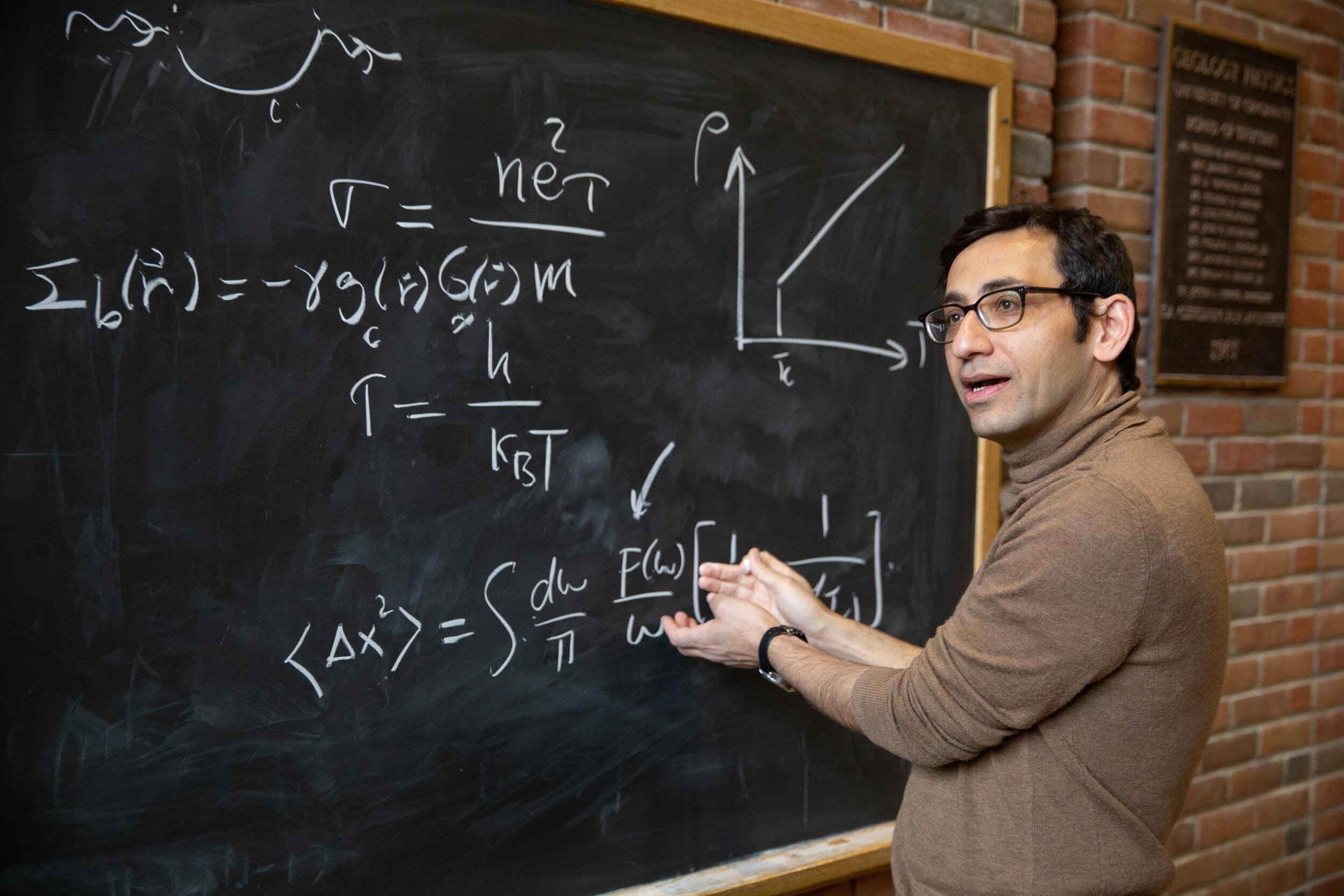博文
《科学》:探索奇怪金属的特性
||
《科学》:探索奇怪金属的特性
诸平
据美国辛辛那提大学(University of Cincinnati)2023年3月11日提供的消息,辛辛那提大学理论物理学家亚沙·科米贾尼(Yashar Komijani)与一个由实验物理学家和理论物理学家组成的国际团队合作,探索奇异金属的奥秘(Physicists explore mysteries of strange metals)。
物理学家们正在对“奇怪金属(strange metals)”的怪异行为有更多了解,这种金属的运行方式超出了正常的电学规律。辛辛那提大学的助理教授、理论物理学家亚沙·科米贾尼参与了一项国际实验,实验使用了一种由稀土金属( rare earth metal)钇(ytterbium)合金制成的奇怪金属。在日本兵库县(Hyogo, Japan)的实验室里,物理学家们向这种奇怪的金属发射了放射性伽马射线,以观察它不寻常的电行为。相关研究结果于2023年3月2日已经在《科学》(Science)杂志网站发表——Hisao Kobayashi, Yui Sakaguchi, Hayato Kitagawa, Momoko Oura, Shugo Ikeda, Kentaro Kuga, Shintaro Suzuki, Satoru Nakatsuji, Ryo Masuda, Yasuhiro Kobayashi, Makoto Seto, Yoshitaka Yoda, Kenji Tamasaku, Yashar Komijani, Premala Chandra, Piers Coleman. Observation of a critical charge mode in a strange metal. Science, 2 Mar 2023, 379(6635): 908-912. DOI: 10.1126/science.abc4787. https://www.science.org/doi/10.1126/science.abc4787
参与此项研究的除了来自美国的辛辛那提大学的研究人员之外,还有来自日本兵库県立大学(University of Hyogo)、日本理化研究所(RIKEN)、日本东京大学(University of Tokyo)、日本京都大学(Kyoto University)、日本广崎大学(Hirosaki University, Aomori, Japan)、日本同步辐射研究所(Japan Synchrotron Radiation Research Institute, Hyogo, Japan);美国约翰霍普金斯大学(Johns Hopkins University, Baltimore, MD, USA)、美国新泽西州的罗格斯大学(Rutgers University, Piscataway, NJ, USA)以及英国伦敦大学(University of London, Egham, UK)的研究人员。这项研究由兵庫県立大学大学院理学研究科研究科長(University of Hyogo, Koto, Hyogo, Japan)和日本理化研究所(RIKEN)的小林寿夫(Hisao Kobayashi)领导。实验揭示了这种奇怪金属电荷(strange metal's electrical charge)的不寻常波动。
亚沙·科米贾尼说:“这个想法是在金属中,你会看到大量的电子在离子晶格的背景中移动。但在量子力学(quantum mechanics)中发生了一件奇妙的事情,你可以忘记离子晶格的复杂性。取而代之的是它们的行为就像处于真空状态一样。”
亚沙·科米贾尼多年来一直在探索与量子力学有关的奇怪金属的奥秘。他说:“你可以把东西放进黑盒子里,我甚至不用看就能告诉你里面有什么,只需测量电阻率(resistivity)、热容量(heat capacity)和电导率(conductivity)。但是,对于奇怪的金属,我不知道为什么它们会表现出这样的行为。神秘的是在这个奇怪的体系里究竟发生了什么?这就是问题所在。”
从粒子物理学(particle physics)到量子力学(quantum mechanics),众多物理学家都对奇怪的金属感兴趣。其中一个原因是,它们具有出奇的高传导性,至少在极冷的温度下也是如此,这就赋予了它们作为量子计算超导体的潜力。
“这些新结果令人激动的地方在于,它们提供了对这种奇怪金属内部机制的全新认识,”上述研究论文的共同通讯作者之一、罗格斯大学的著名教授皮尔斯·科尔曼(Piers Coleman)说,“这些金属为新形式的电子材料提供了画布,尤其是新奇的高温超导性。”
皮尔斯·科尔曼说,受到奇怪金属的启发,现在就推测什么新技术可能会还为时过早。“据说在迈克尔·法拉第(Michael Faraday)发现电磁学(electromagnetism)后,英国财政大臣威廉·格莱斯顿(British Chancellor William Gladstone)问他电磁学有何用途?法拉第回答说,虽然他不知道,但他确信有朝一日政府会对其征税。”迈克尔·法拉第的发现开启了一个创新世界。
皮尔斯·科尔曼说:“我们对这种奇怪的金属也有同样的感觉。如今,金属发挥着如此重要的作用——铜这种最典型的传统金属,存在于我们周围的所有设备、所有电源线之中。”
皮尔斯·科尔曼说,有一天,奇怪的金属(strange metals)可能会在我们的技术中无处不在。
日本的实验具有开创性,部分原因在于研究人员使用一种叫做同步加速器(synchrotron)的粒子加速器(particle accelerator)制造伽马粒子的方式。
亚沙·科米贾尼说:“在日本,他们使用的是一种与欧洲核子研究中心(CERN)类似的同步加速器,它可以加速质子并将其撞向墙壁,然后发出伽马射线。因此,他们拥有一个按需提供伽马射线的来源,而不使用放射性物质。”
研究人员使用光谱学来研究伽马射线对这种奇怪金属的影响。
研究人员还研究了这种金属电荷波动的速度,这种变化仅需一纳秒(1 ns)即十亿分之一秒。亚沙·科米贾尼说,这看起来可能快得难以置信。“然而,在量子世界1 ns就是无穷无尽的时间。长期以来,我们一直在想为什么这些波动会如此缓慢。我们与合作者一起提出了一种理论,即晶格可能存在振动,事实确实如此。”
本研究得到了美国国家科学基金会(National Science Foundation: DMR-1830707, PHY-1607611)、美国能源部(U.S. Department of Energy: DE-SC0020353, DE-SC0019331);日本科学技术振兴机构(Japan Science and Technology Agency: 15K05182, 16H02209, 16H06345, 19H00650, 23102723)、日本理化研究所(RIKEN: 2016110, 20170019, 20180019, 20190025)、日本同步辐射研究所(Japan Synchrotron Radiation Research Institute: 2011A1450, 2012B1521, 2013B1393, 2015A1458, 2016A1363, 2019B1597)、日本学术振兴会创新领域科学研究资助计划(Grants-in-Aids for Scientific Research on Innovative Areas: 15H05882, 15H05883)以及日本科学技术振兴机构进化科学技术核心研究(Core Research for Evolutional Science and Technology, Japan Science and Technology Agency: JPMJCR18T3)的资助。
上述介绍,仅供参考。欲了解更多信息,敬请注意浏览原文或者相关报道。
The strange metal phase, which can form in some strongly correlated materials, is characterized by the breakdown of the usual charge transport laws. Understanding charge dynamics in this exotic phase is, however, hampered by the lack of suitable probes. Kobayashi et al. used synchrotron radiation–based Mossbauer spectroscopy to study these dynamics in the strange metal phase of the heavy fermion metal beta-YbAlB4. The researchers observed a splitting of the Mössbauer absorption peak, which they attributed to unusually slow fluctuations of the ytterbium ion valence in this material. —JS
Understanding the strange metallic behavior that develops at the brink of localization in quantum materials requires probing the underlying electronic charge dynamics. Using synchrotron radiation–based Mössbauer spectroscopy, we studied the charge fluctuations of the strange metal phase of β-YbAlB4 as a function of temperature and pressure. We found that the usual single absorption peak in the Fermi-liquid regime splits into two peaks upon entering the critical regime. We interpret this spectrum as a single nuclear transition, modulated by nearby electronic valence fluctuations whose long time scales are further enhanced by the formation of charged polarons. These critical charge fluctuations may prove to be a distinct signature of strange metals.
https://blog.sciencenet.cn/blog-212210-1380628.html
上一篇:“出乎意料”——研究人员查明了太阳“类心跳”信号的神秘来源
下一篇:《自然》:受体“爆破”可视化
